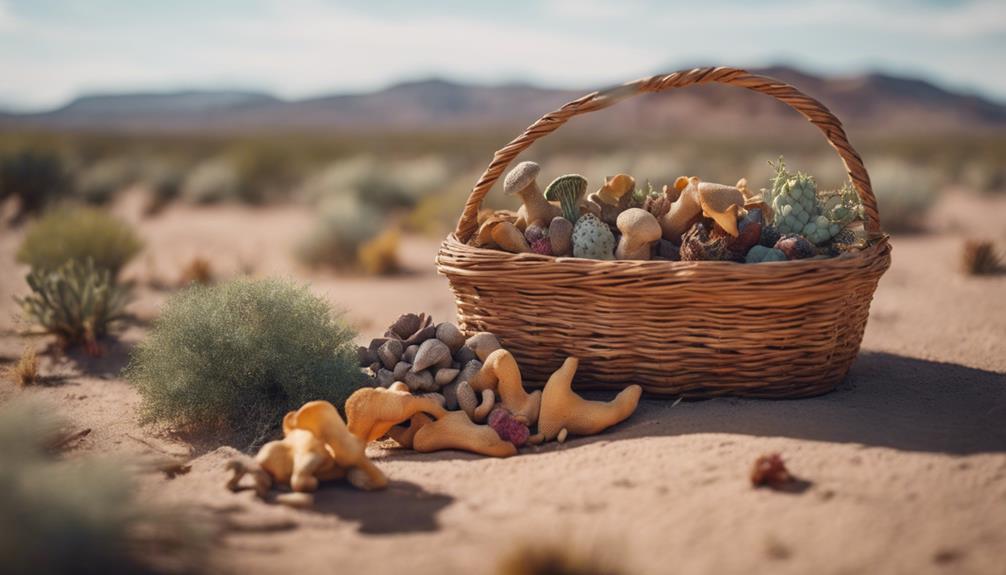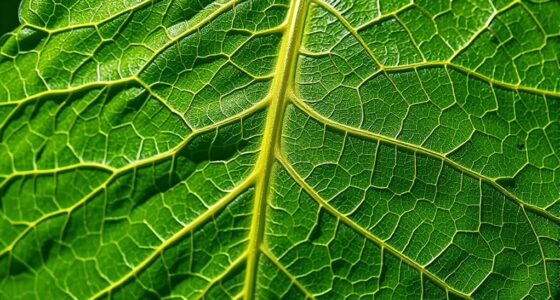To improve your foraging, understanding soil types and mineral clues is key. Soils rich in calcium support strong plant growth and tell you which plants are resilient and nutritious. Look for clues like leaf discoloration or growth patterns that signal mineral deficiencies or soil pH. Recognizing these signs helps you find safe, abundant wild foods adapt to your environment. Keep exploring how geology shapes the landscape, and you’ll uncover even more about thriving foraging spots.
Key Takeaways
- Understanding soil mineral composition reveals plant health and guides foraging to nutrient-rich areas.
- Calcium is vital for plant structure; signs of deficiency help identify soils with lower mineral content.
- Plant visual cues, like leaf discoloration or growth patterns, indicate underlying soil minerals and pH.
- Recognizing soil types (rocky, sandy) and mineral presence informs about edible plant adaptations.
- Knowledge of geology enhances interpretation of landscape and plant clues for sustainable, informed foraging.

Have you ever wondered how understanding geology can enhance your foraging skills? Recognizing the connection between soil minerals and plant health gives you a valuable edge when searching for edible plants. Different soils contain varying mineral compositions, which directly influence the plants that grow there and their nutritional content. By paying attention to soil minerals, you can identify areas rich in specific nutrients or recognize signs of mineral deficiencies in plants. For example, if you see plants with stunted growth or unusual coloration, it might indicate a lack of essential minerals like calcium, magnesium, or iron. Understanding these clues helps you pinpoint not only where edible plants thrive but also where they might be lacking certain nutrients, giving you insights into the soil’s composition.
Recognizing soil mineral clues enhances foraging by revealing plant health and nutrient availability.
Calcium, in particular, plays an essential role in plant development. When plants lack calcium, they often show symptoms like distorted new growth or premature wilting. Recognizing these signs in plants can guide you to areas where the soil might be deficient in calcium or other critical minerals. This knowledge allows you to understand which plants are more likely to flourish in specific soil conditions, making your foraging more efficient. Additionally, knowing about mineral deficiencies can help you select plants that are naturally adapted to less-than-ideal soils, expanding your foraging options. For example, wild plants that grow in rocky or sandy soils often have adapted to survive with fewer available minerals, and knowing this can lead you to discover new edible species.
Your understanding of soil minerals also aids in interpreting plant clues. Visual signs such as leaf discoloration, growth patterns, or fruit production can reveal underlying mineral issues. If a plant exhibits interveinal chlorosis—yellowing between leaf veins—it could suggest iron deficiency, which is common in well-drained, acidic soils. Conversely, overly lush, soft growth might indicate an excess of nitrogen but a deficiency in calcium. Recognizing these subtle signals allows you to assess the soil’s health without needing lab tests, making your foraging more intuitive and sustainable. Moreover, considering soil pH can further refine your understanding of mineral availability and plant health.
In essence, studying geology and soil minerals transforms your ability to read the landscape. You learn to see the hidden story beneath the surface—how mineral content shapes plant growth and, ultimately, the wild edibles you seek. By understanding mineral deficiencies and the role of calcium in plant health, you can better interpret plant clues and choose the most nutritious, resilient species. This knowledge deepens your connection to the land, turning foraging into a more informed, precise, and rewarding adventure.
Frequently Asked Questions
How Can Soil Types Help Identify Edible Plants?
You can identify edible plants by paying attention to soil types, especially soil pH and organic content. For example, many edible greens thrive in slightly acidic to neutral soils with rich organic matter, while others prefer more alkaline conditions. By observing these soil clues, you can determine which plants are likely safe to forage. Soil color, texture, and nutrient levels also provide hints about the plant’s suitability and safety for consumption.
What Minerals in Soil Indicate Safe Foraging Areas?
Think of soil mineralogy as a treasure map guiding your safe foraging. If you find high levels of calcium, magnesium, and potassium, these nutrient indicators suggest healthy, fertile ground. Such minerals hint at areas rich in essential nutrients, making them safer for edible plants. Be attentive to the presence of trace minerals like zinc and manganese, which further confirm the soil’s suitability. Trust these mineral clues to steer you toward safer, nourishing foraging spots.
How Does Calcium in Soil Affect Plant Growth?
Calcium in soil promotes strong cell walls, boosting plant growth and overall health. If your soil has a calcium deficiency, plants may become weak, with stunted development or poor fruiting. To fix this, you can apply a soil amendment rich in calcium, like lime or gypsum. This guarantees your plants get the nutrients they need, encouraging vigorous growth and better resilience against pests and diseases.
Can Soil Analysis Predict Plant Toxicity?
Soil analysis can indeed help predict plant toxicity, especially since over 70% of plant issues relate to mineral deficiencies and soil acidity. By testing these factors, you can identify harmful imbalances that might cause toxic plants or inhibit growth. Monitoring soil pH and mineral content allows you to adjust nutrients accordingly, preventing toxicity and ensuring healthy plants. Regular analysis keeps you ahead of potential problems before they affect your foraging success.
How Does Geology Influence Regional Plant Diversity?
You can see how geology shapes regional plant diversity through rock formations and erosion patterns. These features determine soil composition, nutrient availability, and water retention, influencing which plants thrive. For example, limestone areas support calcium-loving species, while acidic volcanic soils host different plants. Erosion exposes new minerals and creates varied habitats, encouraging diverse plant communities. Your understanding of these geological processes helps predict plant distribution and guides foraging or conservation efforts.
Conclusion
As you walk through the rugged terrain, imagine the hidden stories beneath your feet—ancient soils whispering secrets of calcium and minerals. With every step, you tap into the land’s silent clues, revealing nature’s pantry. By reading these subtle signs, you become a true forager, connecting deeply with the earth’s quiet wisdom. Embrace this skill, and let the soil’s silent language guide you to nourishment and discovery in every lush, earthy breath you take.










